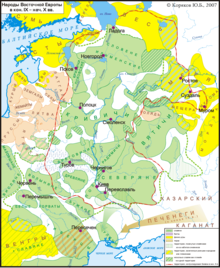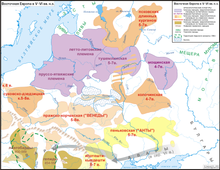Golyad

The Goljad or eastern Galindians (Russian Голядь , English Eastern Galindians ) were a most likely a Baltic tribe in the area around Moscow in Russia . They would be the easternmost known Baltic tribe and also the easternmost and longest-handed group of the so-called Dnepr-Balts , which were Slavicized into the 15th century.
Distribution area
According to the written tradition and place and a river name, the settlement area of the Golyad was on the Protwa near Moscow, a longer tributary of the Oka and reached as far as the Oka and in the vicinity of the longer Oka tributaries Ugra and Moskva, which are adjacent on both sides .
After the Golyad themselves are named:
- Golyadanka , tributary of the Moskva River in the urban area of Moscow (historical name)
- Golyadi , village in Dmitrovsky rajon in Moscow Oblast
- Golyadi , village in the Klinsky rajon in Moscow Oblast
- Goljashe , village near Bryansk , (historical name), today Otradnoe in Moscow Oblast
In addition, there are numerous other hydronymes ( names of waters) in the region, the original meaning of which, according to research since the 1970s, can only be explained with the Baltic languages , including East Baltic names, around the Oka but also increasingly word stems from the West Baltic language branch. Sedov and some other archaeologists propose that the names of the west Baltic branch came in the 1st century AD with the migration of carriers of the Sarubinzy culture to the more northern, possibly east Baltic Dnepr-Dvina culture .
In this area there are traces of the Baltic archaeological Moschtschiny culture from the 4th to 7th centuries, which combines influences from the Sarubinsky and Dnepr-Dvina cultures. A connection with the tribe of the Golyad is assumed by Russian archaeologists. This culture also extended to Kaluga and Smolensk Oblast . Overall, an archaeological continuity can be observed in the region from pre-Christian times to the Middle Ages.
Neighboring tribes in the 10th century were the East Slavic tribes of the Vyatichs and Kriwitschen , who also have Baltic influences, because they accepted the Baltic pre-population into their tribal associations and gradually assimilated them . A characteristic ceramic or burial in the Kurgan (burial mound) , which replaced the older Slavic cremation , was one of the influences that were adopted.
Surname
The Old Russian name was Golend , from which the Russian Goljad was derived (Old Russian -en becomes Russian -ja ). Therefore they are often with the since the 2nd century mentioned Old Prussian -westbaltischen part tribe of Galindians in the historical region Galindia in the south of the later East Prussia , the later region Mazury associated. Older hypotheses that they could be a group of Prussian Galindians who had emigrated or were prisoners of war are no longer supported due to the archaeological continuity. The Goljad, like their predecessor cultures, practiced body burial in Kurganen, while the Prussian tribes, from pre-Christian times until the final establishment of Christianity in the 12th century, practiced cremation with subsequent urn burial in barrows. The factually identical name probably comes from the use of common old Baltic names. The old Baltic word stem * galind could mean "depth" or "end", the tribe name means in both cases "those who live in the depths / at the end / at the edge".
history
Already in the 6th century Jordanes mentioned a tribe in the region with the Baltic name Coldas .
The Golyad is mentioned for the first time in 1058, when the Grand Duke of the Kievan Rus , Isjaslav I , defeated the Golyad near Smolensk . In 1147, Prince of Chernigov, Svyatoslav Olgovich, conquered their territory. From the year 1248 two campaigns of the Moscow prince Mikhail Yaroslavovich Khorobrit against the "Lithuanians on the Protva " are handed down. Because the real Lithuanians in the 13th century did not show any expansive tendencies as far as the Protwa region, it is sometimes assumed that this meant the Baltic Goljad who lived in the vicinity of the Protwa.
The Golyad have been handed down in the 15th century . In the 19th century, Russian-speaking rural residents of the region referred to themselves as "Golyad" and some natural places are associated with the "old Golyad" in popular tales.
Also in the Moscow region, about 200 km to the east, the settlement areas of the Finno-Ugric tribal associations of the Meshchers , Merja and Muroma , which can be traced back to ancient times and which also gradually adopted the Russian language until the late Middle Ages, began.
Web links
- WW Sedov: Goljad ( Memento of the original from November 29, 2014 in the Internet Archive ) Info: The archive link was inserted automatically and has not yet been checked. Please check the original and archive link according to the instructions and then remove this notice.
literature
- Jan Jaskanis: The Balts, The Northern Neighbors of the Slavs , Karl Schillinger, Freiburg 1987, p. 44.
- WW Sedow , Wostochnye slavyane w VI - XIII ww. Moscow 1982
Remarks
- ↑ Tarasov I. The balts in the Migration Period. PI Galindians
- ↑ WW Sedov: Goljad ( Memento of the original from November 29, 2014 in the Internet Archive ) Info: The archive link was automatically inserted and not yet checked. Please check the original and archive link according to the instructions and then remove this notice. , seventh and twelfth paragraphs
- ↑ WW Sedov: Goljad ( Memento of the original from November 29, 2014 in the Internet Archive ) Info: The archive link was automatically inserted and not yet checked. Please check the original and archive link according to the instructions and then remove this notice. , fifteenth paragraph
- ↑ Tarasov I. The balts in the Migration Period. PI Galindians, p. 98
- ↑ WW Sedov: Goljad ( Memento of the original from November 29, 2014 in the Internet Archive ) Info: The archive link was automatically inserted and not yet checked. Please check the original and archive link according to the instructions and then remove this notice.
- ↑ WW Sedov: Goljad ( Memento of the original from November 29, 2014 in the Internet Archive ) Info: The archive link was automatically inserted and not yet checked. Please check the original and archive link according to the instructions and then remove this notice. , from the 16th paragraph to the end of the article
- ↑ cf. Jatwinger : Latin Jatwingi > Old Russian Jatwengi > Russian Jatwjagi
- ↑ WW Sedov: Goljad ( Memento of the original from November 29, 2014 in the Internet Archive ) Info: The archive link was automatically inserted and not yet checked. Please check the original and archive link according to the instructions and then remove this notice. , third paragraph
- ↑ WW Sedov: Goljad ( Memento of the original from November 29, 2014 in the Internet Archive ) Info: The archive link was automatically inserted and not yet checked. Please check the original and archive link according to the instructions and then remove this notice. , second paragraph
- ↑ WW Sedow: Wostochnye slavyane w VI - XIII ww. , P. 45.
- ↑ R. Wixman: The peoples of the USSR - An Ethnographic Handbook , New York 1984
